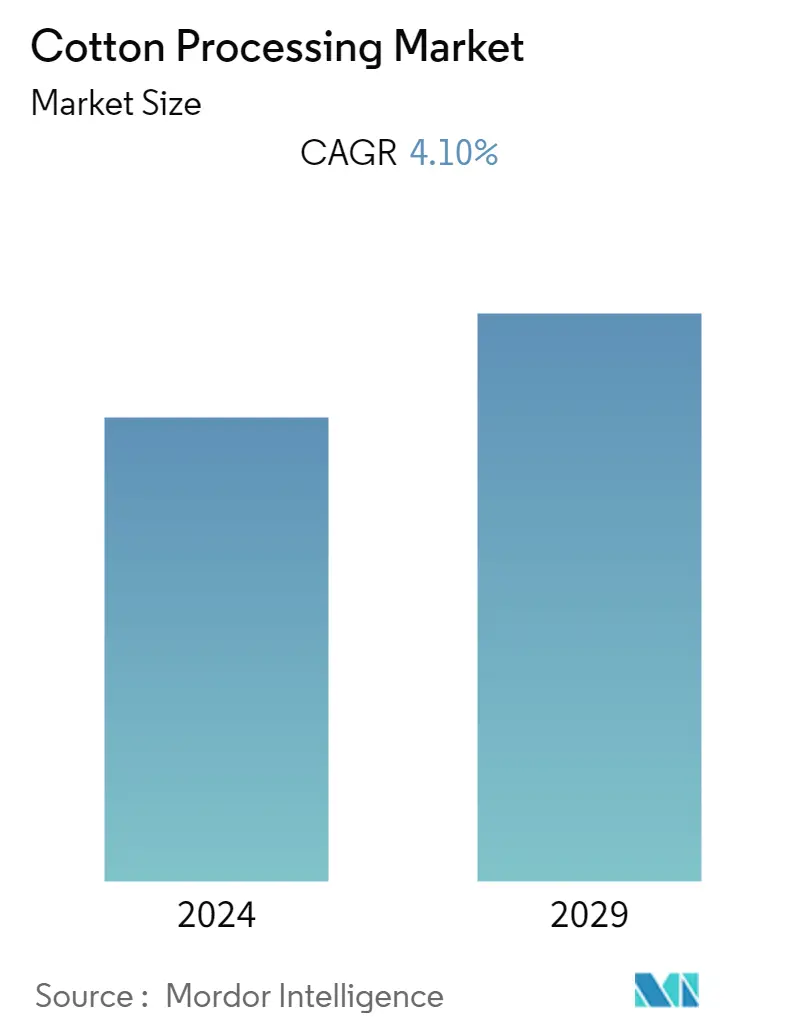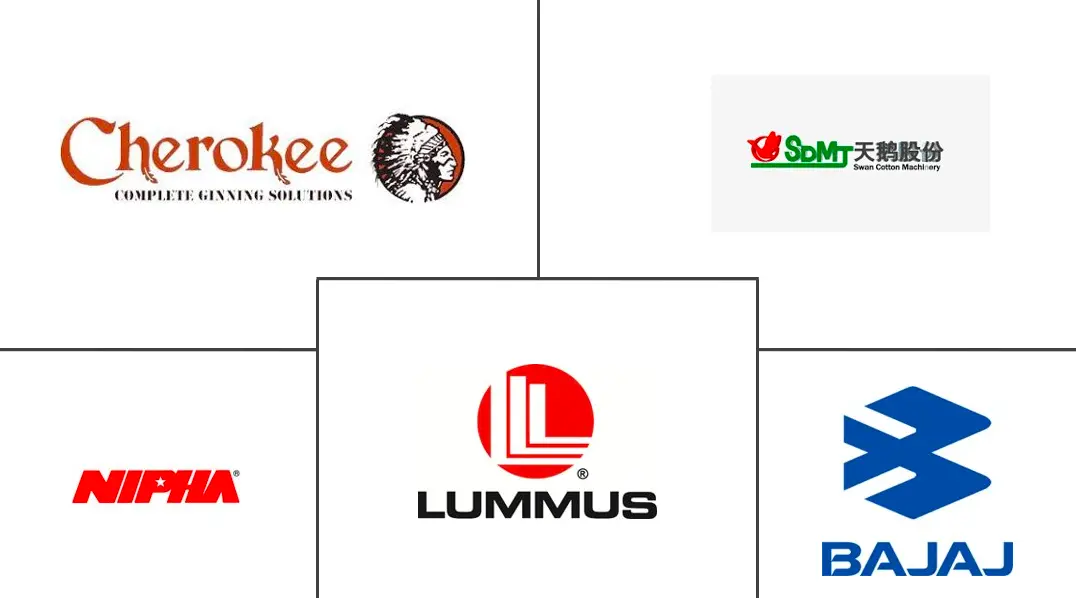Market Size of Cotton Processing Industry

| Study Period | 2019 - 2029 |
| Base Year For Estimation | 2023 |
| CAGR | 4.10 % |
| Fastest Growing Market | Asia Pacific |
| Largest Market | Asia Pacific |
| Market Concentration | High |
Major Players
*Disclaimer: Major Players sorted in no particular order |
Cotton Processing Market Analysis
The cotton processing market is projected to register a CAGR of 4.1% during the forecast period,
- The market is likely to be driven by the rising demand for processed cotton, especially from the cotton textile and medical and surgical markets. Raw cotton is used as a key ingredient in textile manufacturing applications, and there are no raw materials to substitute it. Hence, the textile segment has accounted for the largest share of the global cotton processing market.
- In 2022, The Noida Apparel Export Cluster (NAEC) seeked intervention from the government in containing the high cost of cotton yarn and fabrics, saying rising prices are impacting exporters. Indian exporters are losing export orders and facing tough competition in the global export market. Moreover, they are also losing the confidence of the importers and hurting production costs. NAEC president suggested control of cotton exports, removal of 10 percent cotton import duty, and development of a mechanism to regulate the prices of cotton and other raw materials to support the sector. This will raise the growth of the market in the coming years.
- The textile industry's production of fiber through the manufacturing of consumer end products is complicated, with the content of the material often determining the end use. So, The federal government of the United States and the government of India has enacted several laws and regulations governing the sale of textile fibers, materials, and products within the country. According to the Textile Fiber Products Identification Act (TFPIA), specific information about the fiber content of textile products must be included on labels that are prominently attached and securely affixed to the item at the time of sale and delivery to the final consumer. This will develop the bonding between consumers and manufacturers for building the cotton sector and will drive the market to grow during the anticipated years.
- The market is dominated by the Asia Pacific region owing to the high production of cotton in the countries of China, India, and Pakistan. Cotton lint finds application in manufacturing different types of surgical bandages, apparel, and household textiles. The rise in urbanization and change in the lifestyle of consumers has led to an increase in the demand for textiles, which, in turn, is projected to drive the growth of the lint segment further.
Cotton Processing Industry Segmentation
The cotton processing market includes machinery used to convert raw cotton into forms utilized by several industries, like medical and textile. The Cotton Processing Market is Segmented by Product Type (Lint, Cottonseed, and Other Product Types), Application (Textiles, Surgical and Medical, Feed, and Other Applications), Equipment (Spinning, Ginning, and Other Equipment), Operation (Automatic, Semi-automatic, and Other Operations), and Geography (North America, Europe, Asia Pacific, South America, and Africa). The report offers market sizing and forecasts in terms of value (USD million) for all the above segments.
| Cotton Product Type | |
| Lint | |
| Cottonseed | |
| Other Product Types |
| Application | |
| Textiles | |
| Surgical and Medical | |
| Feed | |
| Other Applications |
| Equipment | |
| Spinning | |
| Ginning | |
| Other Equipment |
| Operation | |
| Automatic | |
| Semi-Automatic | |
| Other Operations |
| Geography | ||||||||
| ||||||||
| ||||||||
| ||||||||
| ||||||||
|
Cotton Processing Market Size Summary
The cotton processing market is experiencing a steady growth trajectory, driven primarily by the increasing demand for processed cotton in the textile and medical sectors. The textile industry, being the largest segment, relies heavily on raw cotton due to the absence of viable substitutes, which underscores its significance in the market. The Asia Pacific region, particularly countries like China, India, and Pakistan, dominates the market due to their substantial cotton production and burgeoning textile industries. The rise in urbanization and changing consumer lifestyles are further propelling the demand for cotton textiles, thereby enhancing the market's growth prospects. Additionally, government interventions and regulations in major producing countries aim to stabilize cotton prices and support the sector, which is expected to contribute positively to market expansion.
The global cotton processing market is characterized by a consolidated structure, with a few key players holding significant market shares. Companies such as Lummus Corp., Cherokee Fabrication, and Shandong Swan Cotton Industrial Machinery Stock Co. are actively investing in expanding their operations and tailoring products to meet consumer preferences, particularly in the Asia Pacific and North American regions. The market is also witnessing a shift towards organic cotton production, supported by government initiatives in countries like India, which are promoting sustainable farming practices. Despite the competition from synthetic fibers, the demand for cotton remains robust, driven by its applications in various sectors, including textiles, medical, and consumer goods. The market's growth is further supported by technological advancements aimed at enhancing productivity and addressing the rising awareness of product quality among consumers.
Cotton Processing Market Size - Table of Contents
-
1. MARKET DYNAMICS
-
1.1 Market Overview
-
1.2 Market Drivers
-
1.3 Market Restraints
-
1.4 Porter's Five Forces Analysis
-
1.4.1 Bargaining Powers of Buyers
-
1.4.2 Bargaining Powers of Suppliers
-
1.4.3 Threat of New Entrants
-
1.4.4 Threat from Substitute Products and Services
-
1.4.5 Intensity of Competitive Rivalry
-
-
-
2. MARKET SEGMENTATION
-
2.1 Cotton Product Type
-
2.1.1 Lint
-
2.1.2 Cottonseed
-
2.1.3 Other Product Types
-
-
2.2 Application
-
2.2.1 Textiles
-
2.2.2 Surgical and Medical
-
2.2.3 Feed
-
2.2.4 Other Applications
-
-
2.3 Equipment
-
2.3.1 Spinning
-
2.3.2 Ginning
-
2.3.3 Other Equipment
-
-
2.4 Operation
-
2.4.1 Automatic
-
2.4.2 Semi-Automatic
-
2.4.3 Other Operations
-
-
2.5 Geography
-
2.5.1 North America
-
2.5.1.1 United States
-
2.5.1.2 Canada
-
2.5.1.3 Mexico
-
2.5.1.4 Rest of North America
-
-
2.5.2 Europe
-
2.5.2.1 United Kingdom
-
2.5.2.2 France
-
2.5.2.3 Italy
-
2.5.2.4 Spain
-
2.5.2.5 Germany
-
2.5.2.6 Rest of Europe
-
-
2.5.3 Asia Pacific
-
2.5.3.1 China
-
2.5.3.2 India
-
2.5.3.3 Japan
-
2.5.3.4 Australia
-
2.5.3.5 Rest of Asia Pacific
-
-
2.5.4 South America
-
2.5.4.1 Brazil
-
2.5.4.2 Argentina
-
2.5.4.3 Rest of South America
-
-
2.5.5 Africa
-
2.5.5.1 South Africa
-
2.5.5.2 Rest of Africa
-
-
-
Cotton Processing Market Size FAQs
What is the current Cotton Processing Market size?
The Cotton Processing Market is projected to register a CAGR of 4.10% during the forecast period (2024-2029)
Who are the key players in Cotton Processing Market?
Lummus Corp., NIPHA EXPORTS PRIVATE LIMITED, Bajaj Group of Companies, Shandong Swan Cotton Industrial Machinery Stock Co. and Cherokee Fabrication are the major companies operating in the Cotton Processing Market.

